DNS Load Balancing
Updated on Jun 30, 2025 · 16 mins read
In today’s digital-first world, where users demand fast, reliable, and uninterrupted access to web applications, the ability to efficiently distribute traffic across servers is critical. DNS load balancing is a foundational technique that enables organizations to achieve this by leveraging the Domain Name System (DNS) to intelligently route user requests to the most optimal servers. Whether it’s a global e-commerce platform handling millions of transactions or a streaming service delivering high-definition content, DNS load balancing plays a pivotal role in ensuring seamless performance and high availability.
Summary
How It Works:
- A user queries a domain name.
- The DNS server returns multiple IP addresses.
- The user’s device selects one and sends the request.
- The DNS server rotates or prioritizes IP addresses to balance traffic.
Load Balancing Mechanisms:
- Round-Robin: Distributes traffic sequentially.
- Weighted Round-Robin: Assigns different weights to servers based on capacity.
- GeoDNS: Routes users to the nearest server based on location.
- Latency-Based Routing: Directs users to the lowest-latency server.
Key Benefits:
- Performance Optimization: Reduces latency and distributes traffic efficiently.
- Scalability: Handles traffic spikes without significant overhead.
- Fault Tolerance: Reroutes traffic to healthy servers during failures.
Challenges:
- DNS Caching can cause delays in traffic redistribution.
- Lack of real-time health monitoring without third-party integration.
- Propagation delays affect failover speed.
Modern Solutions:
- Health Checks & Monitoring: Automatically removes unhealthy servers.
- Dynamic Traffic Management: Adjusts routing based on real-time server load.
- CDN Integration: Enhances performance by caching content closer to users.
Popular DNS Load Balancing Services:
- Amazon Route 53 – Advanced traffic policies & health checks.
- Cloudflare DNS – Anycast DNS with security features.
- Google Cloud DNS – Low-latency global DNS with integration to GCP.
DNS load balancing is an essential tool for global web applications, providing high availability and optimal performance. With advancements in health monitoring and dynamic traffic management, it continues to be a cornerstone of internet infrastructure.
At its core, DNS load balancing works by returning multiple IP addresses for a single domain name, allowing traffic to be distributed across several servers. This approach not only improves fault tolerance by rerouting traffic away from failed servers but also enhances performance by directing users to the nearest or least congested server. Unlike traditional load balancers, which operate at the application or transport layer, DNS load balancing operates at the DNS layer, making it a lightweight, cost-effective, and scalable solution for global traffic management.
Why DNS Load Balancing Matters
Traditional load balancing relies on software like HAProxy to distribute traffic efficiently. But what happens when the load balancer itself becomes a bottleneck? This is where DNS load balancing comes in. It not only distributes traffic at the DNS level but also offers additional benefits like geoDNS, which we’ll explore later in this article.
Here’s why DNS load balancing is crucial:
- Performance Optimization: By reducing latency and evenly distributing traffic, it enhances response times for users.
- Scalability: It helps organizations handle traffic surges and expand their infrastructure with minimal overhead.
- Fault Tolerance: In case of server failures, DNS load balancing redirects traffic to healthy servers, ensuring minimal downtime and uninterrupted service.
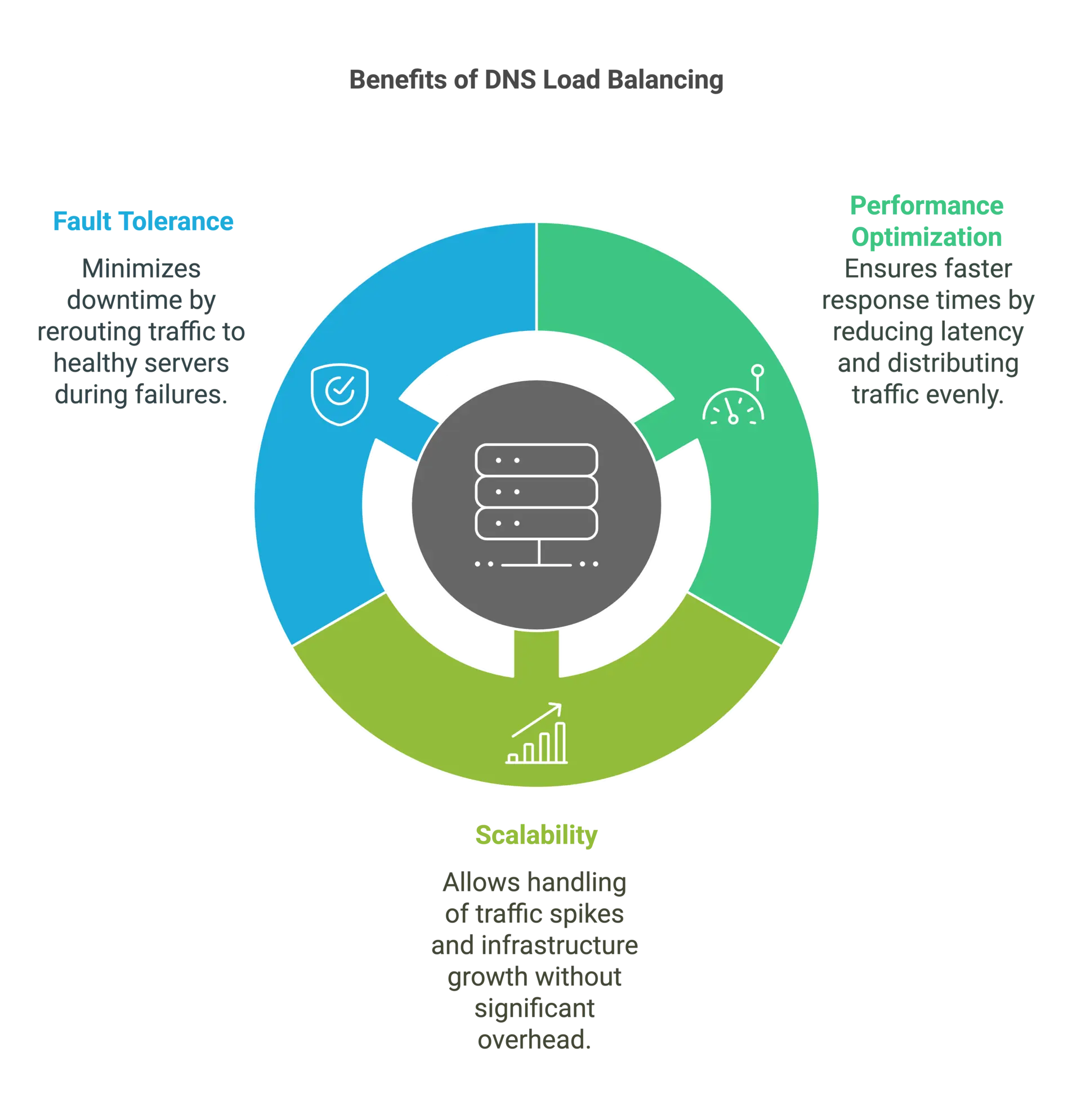
As businesses continue to expand their digital footprint, DNS load balancing has become an indispensable tool for delivering high-quality user experiences. This article explores the mechanisms, benefits, challenges, and best practices of DNS load balancing, providing a comprehensive guide for implementing this critical technology.
What is DNS Load Balancing?
DNS load balancing is a method of distributing incoming traffic across multiple servers by leveraging the Domain Name System (DNS). When a user attempts to access a website or application, their device sends a DNS query to resolve the domain name into an IP address. In a traditional setup, the DNS server returns a single IP address. However, with DNS load balancing, the server returns multiple IP addresses associated with the domain, allowing traffic to be distributed across several servers.
How DNS Load Balancing Works:
- User Query: A user enters a domain name (e.g.,
example.com) in their browser. - DNS Resolution: The DNS server receives the query and responds with multiple IP addresses (e.g.,
192.0.2.1,192.0.2.2,192.0.2.3). - Traffic Distribution: The user’s device selects one of the IP addresses (often based on the order provided) and sends the request to the corresponding server.
- Load Balancing: Subsequent queries return the IP addresses in a rotated or prioritized order, ensuring even distribution of traffic.
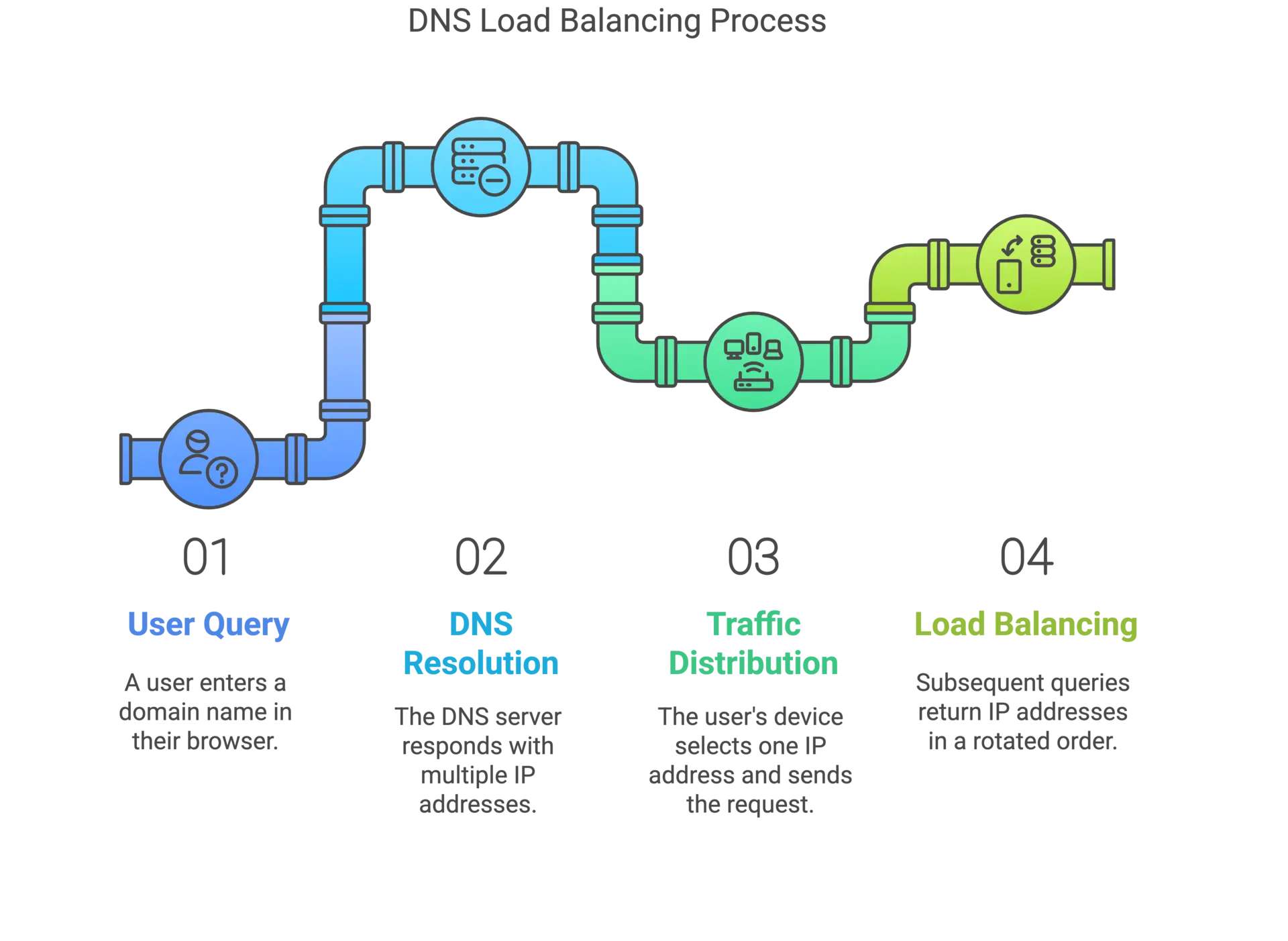
Key Components:
- A/AAAA Records: DNS load balancing relies on A records (for IPv4) and AAAA records (for IPv6) to map domain names to multiple IP addresses.
- Time-to-Live (TTL): The TTL value determines how long DNS responses are cached by clients and resolvers. Lower TTL values allow for faster updates but increase DNS query volume.
- Routing Policies: Advanced DNS load balancing solutions use routing policies (e.g., round-robin, weighted, geographic, latency-based) to optimize traffic distribution.
Comparison with Traditional Load Balancers:
- DNS Load Balancing:
- Operates at the DNS layer (Layer 3).
- Does not require additional hardware or software.
- Lacks real-time server health monitoring (without third-party integration).
- Relies on DNS caching, which can lead to delays in traffic redistribution.
- Traditional Load Balancers:
- Operate at the application or transport layer (Layer 7 or Layer 4).
- Provide real-time health checks and advanced traffic management features.
- Require additional infrastructure and configuration.
- Offer finer control over traffic distribution and server health.
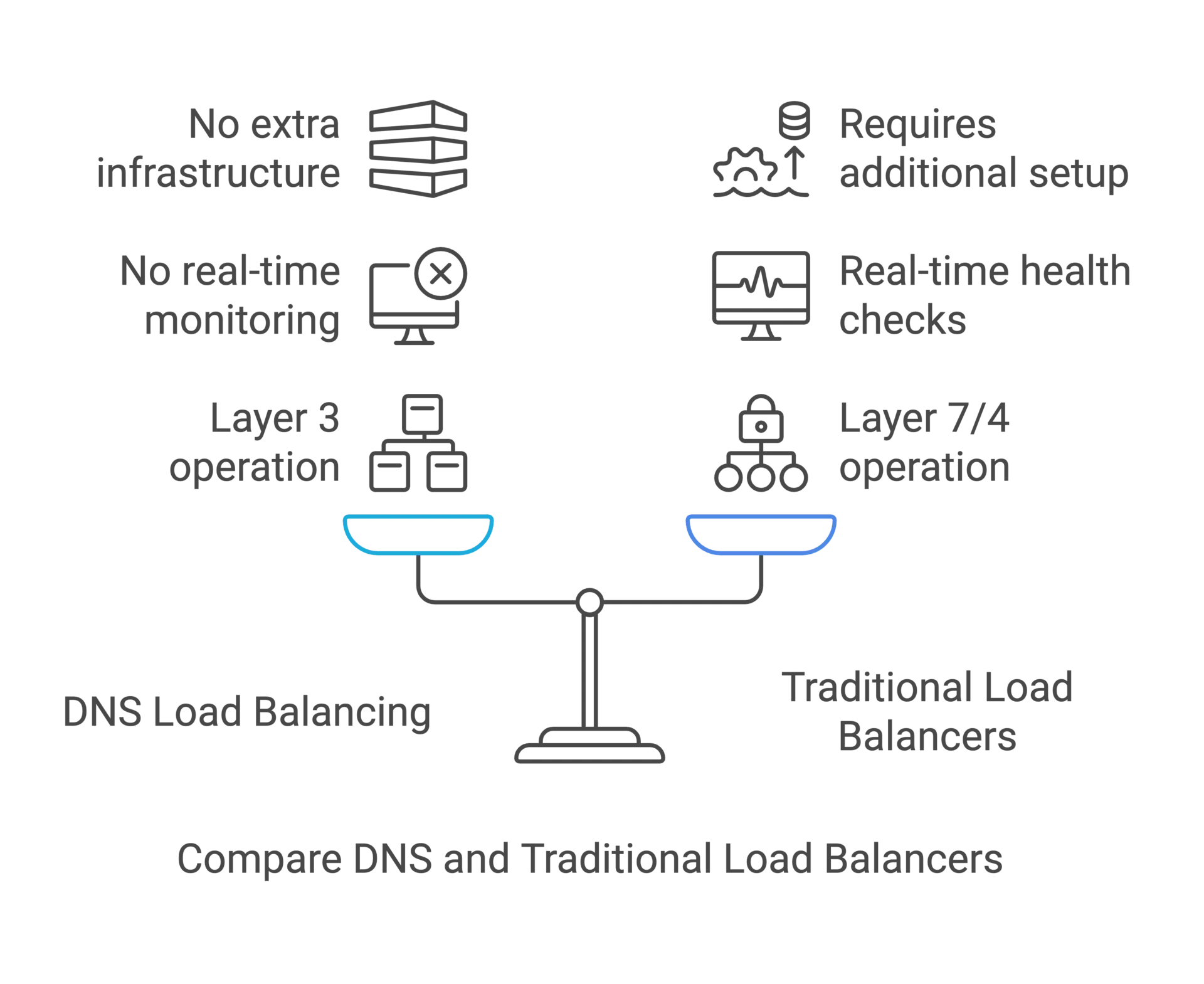
Use Cases:
- Global Applications: DNS load balancing is ideal for applications with a global user base, as it can route users to the nearest server based on their geographic location.
- High Availability: By distributing traffic across multiple servers, DNS load balancing ensures that the failure of a single server does not disrupt the entire service.
- Traffic Spikes: During periods of high traffic, DNS load balancing can prevent server overload by evenly distributing requests.
Example Scenario: Imagine a popular e-commerce website that experiences a surge in traffic during a holiday sale. Without DNS load balancing, all users would be directed to a single server, leading to potential crashes and slow response times. With DNS load balancing, the website can distribute traffic across multiple servers, ensuring that users experience fast and reliable access even during peak periods.
In summary, DNS load balancing is a powerful and versatile technique for optimizing traffic distribution, improving performance, and ensuring high availability. While it has its limitations, such as reliance on DNS caching and lack of real-time health monitoring, modern solutions and best practices have made it an essential tool for managing global web applications.
Mechanisms of DNS Load Balancing
DNS load balancing employs several mechanisms to distribute traffic across multiple servers. Each mechanism has its own strengths and is suited to different use cases. Below, we explore the most common mechanisms in detail.
Round-Robin DNS
Round-robin DNS is the simplest and most widely used mechanism for DNS load balancing. It works by rotating the order of IP addresses returned in DNS responses, ensuring that traffic is distributed evenly across all available servers.
How It Works:
- A domain name (e.g.,
example.com) is associated with multiple IP addresses (e.g.,192.0.2.1,192.0.2.2,192.0.2.3). - When a user queries the domain, the DNS server returns the list of IP addresses in a rotated order.
- First query:
[192.0.2.1, 192.0.2.2, 192.0.2.3] - Second query:
[192.0.2.2, 192.0.2.3, 192.0.2.1] - Third query:
[192.0.2.3, 192.0.2.1, 192.0.2.2]
- First query:
- The user’s device selects the first IP address in the list and sends the request to that server.
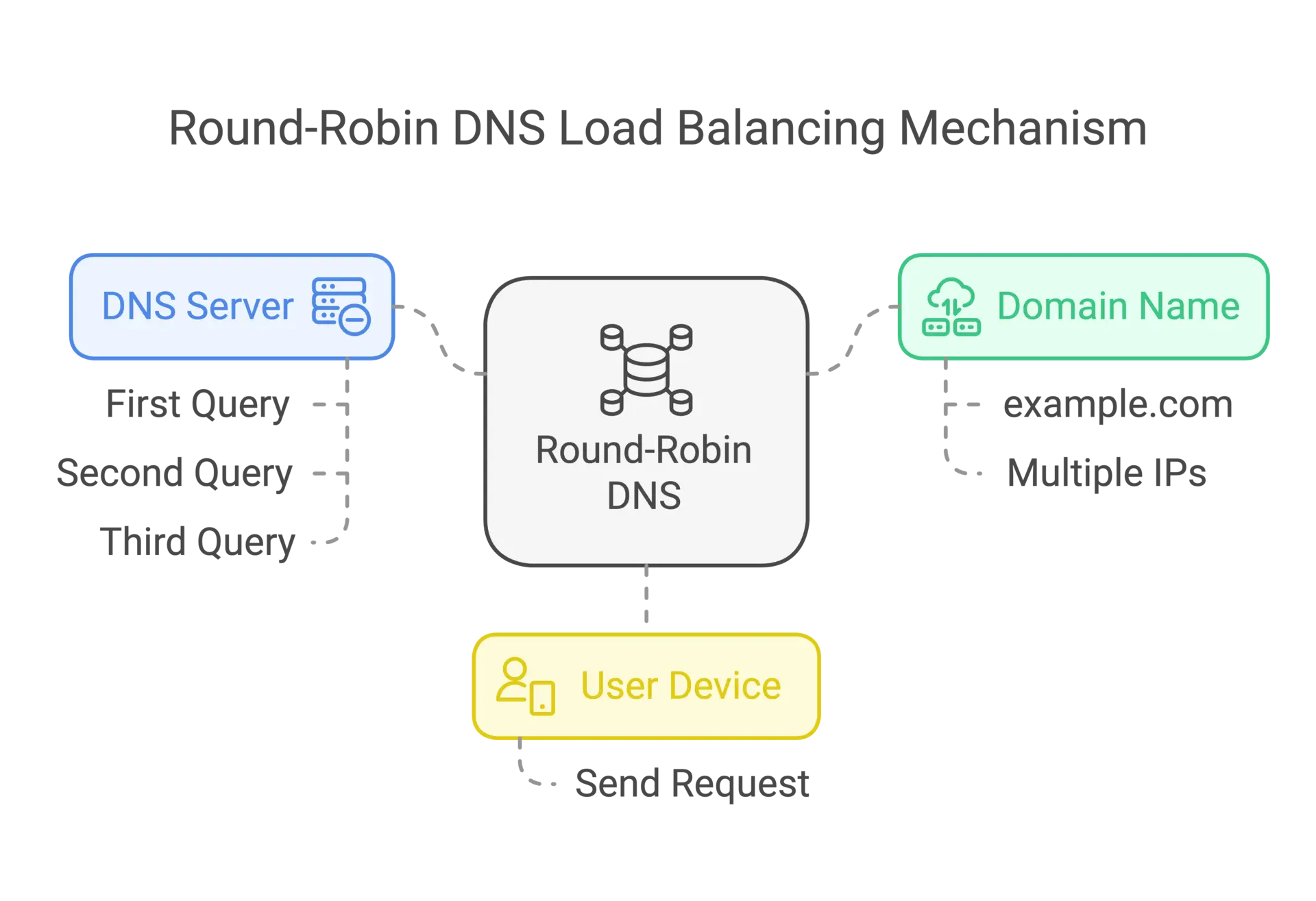
Advantages:
- Simplicity: Easy to implement and requires no additional hardware or software.
- Fair Distribution: Ensures that traffic is evenly distributed across servers.
Limitations:
- No Server Health Awareness: Does not account for server load or health, which can lead to traffic being sent to overloaded or failed servers.
- Caching Issues: DNS responses are cached by clients and resolvers, delaying updates when servers are added or removed.
Use Case: Round-robin DNS is ideal for small-scale applications with servers of similar capacity and no need for advanced traffic management.
Weighted Round-Robin
Weighted round-robin is an extension of round-robin DNS that assigns weights to servers based on their capacity or priority. Servers with higher weights receive a larger share of traffic.
How It Works:
- Each server is assigned a weight (e.g., Server A: 50, Server B: 30, Server C: 20).
- The DNS server returns IP addresses in proportion to their weights.
- Server A (weight 50) will receive 50% of the traffic.
- Server B (weight 30) will receive 30% of the traffic.
- Server C (weight 20) will receive 20% of the traffic.
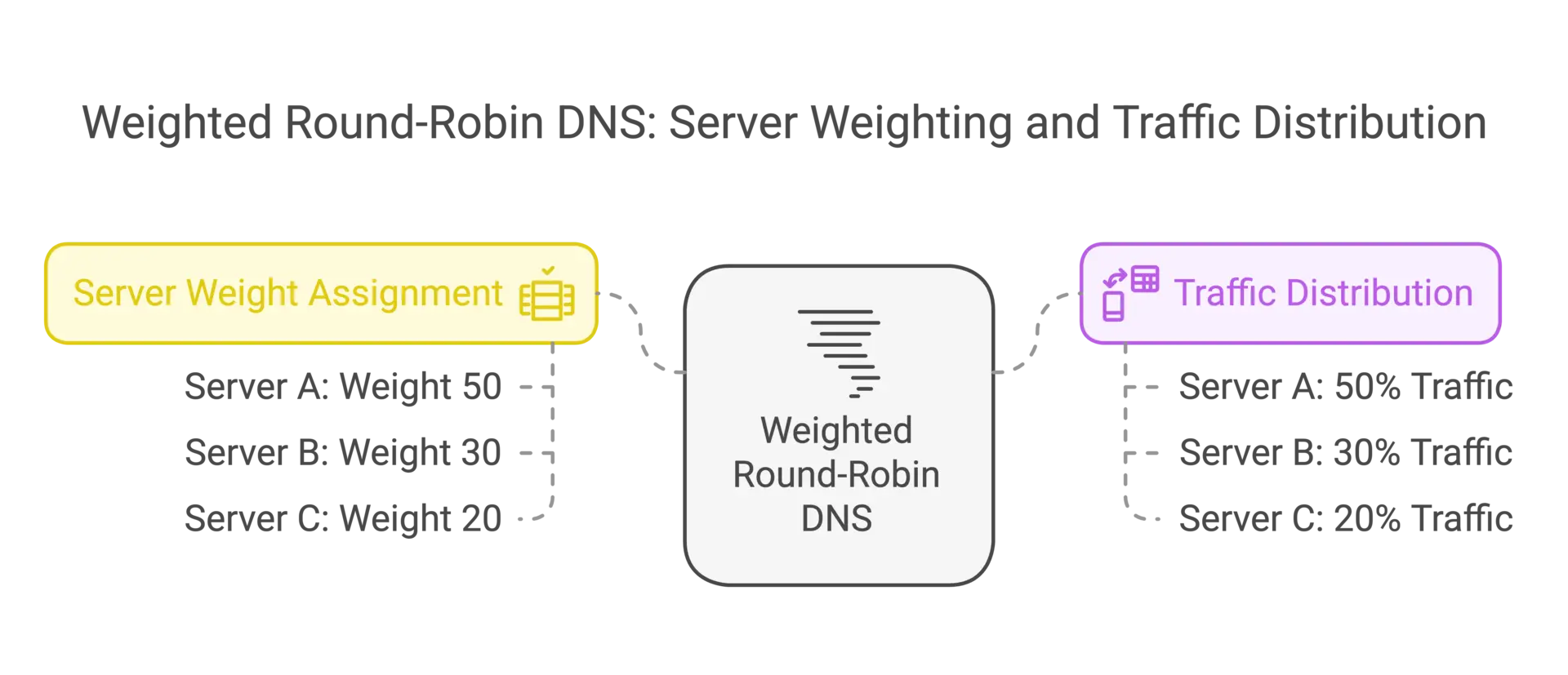
Advantages:
- Flexibility: Allows administrators to prioritize high-capacity servers.
- Efficient Resource Utilization: Ensures that powerful servers handle more traffic.
Use Case: Weighted round-robin is useful for environments with servers of varying capacities, such as a mix of high-performance and legacy servers.
Geographic Routing (GeoDNS)
Geographic routing, also known as GeoDNS, directs users to the closest server based on their geographic location. This reduces latency and improves performance for global applications.
How It Works:
DNS Lookup Based on User Location:
- When a user requests
www.xyz.com, their DNS query is processed based on their geographical location.
- When a user requests
Mapping to the Nearest Server:
- The DNS resolver uses GeoDNS to identify the user’s approximate location.
- The system then directs the request to the closest or most appropriate server.
Example from the Image:
- A user in South America queries
www.xyz.com. The GeoDNS resolves it to the IP address169.148.132.85, located in North America. - A user in Europe queries the same domain, but GeoDNS resolves it to
169.148.128.85, which is closer to their region.
- A user in South America queries
This mechanism helps improve website performance, reduce latency, and balance traffic efficiently across multiple data centers worldwide.
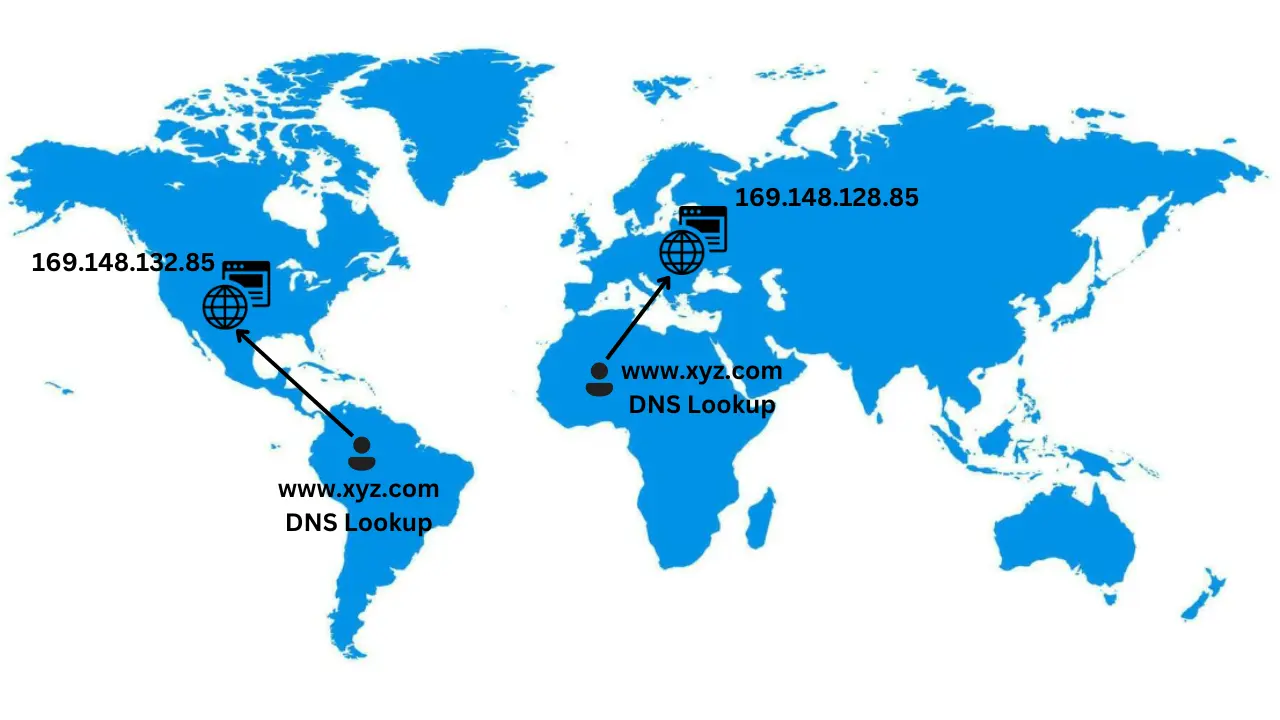
Advantages:
- Reduced Latency: Users experience faster response times by connecting to nearby servers.
- Regional Compliance: Ensures compliance with data localization regulations.
Use Case: Geographic routing is ideal for global applications like content delivery networks (CDNs) and streaming services.
Latency-Based Routing
Latency-based routing selects the server with the lowest measured network delay for the user. This ensures that users are always connected to the fastest available server.
How It Works:
- The DNS provider periodically measures latency between global networks and servers.
- When a user queries the domain, the DNS server returns the IP address of the server with the lowest latency for that user.
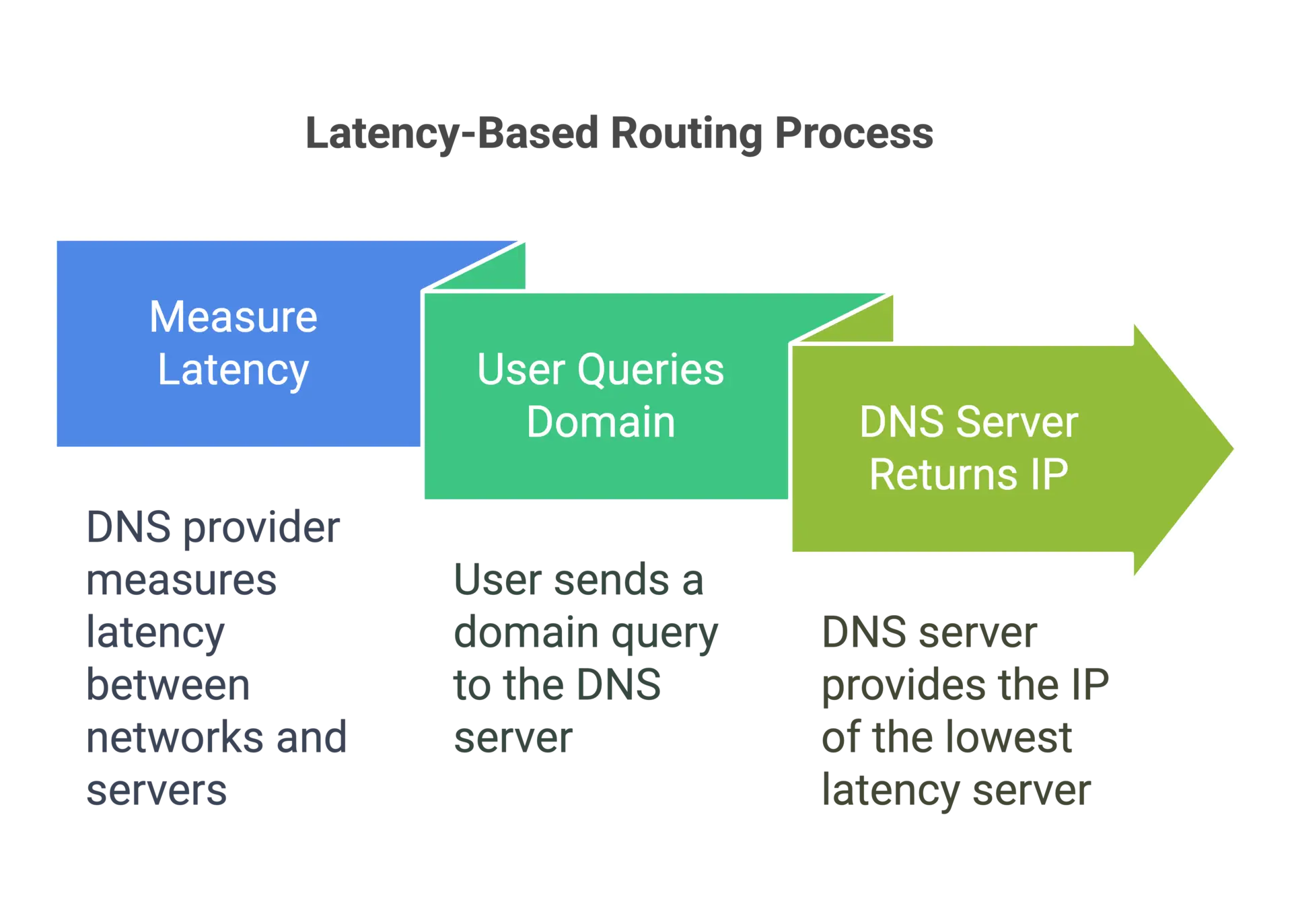
Advantages:
- Optimal Performance: Users are always connected to the fastest server, regardless of geographic location.
- Adaptability: Automatically adjusts to network congestion or outages.
Use Case: Latency-based routing is ideal for real-time applications like online gaming and video conferencing.
Benefits of DNS Load Balancing
DNS load balancing offers several benefits that make it an essential tool for modern web applications. Below, we explore these benefits in detail.
Performance Optimization
DNS load balancing improves performance by distributing traffic across multiple servers, preventing any single server from becoming overloaded. Additionally, mechanisms like geographic and latency-based routing ensure that users are connected to the nearest or fastest server, reducing latency and improving response times.
Key Advantages:
- Efficient Resource Utilization: Traffic is evenly distributed, ensuring that all servers are utilized effectively.
- Faster Response Times: Users experience minimal latency by connecting to optimal servers.
Fault Tolerance & High Availability
DNS load balancing enhances fault tolerance by rerouting traffic away from failed or unhealthy servers. This ensures that users can continue accessing the service even if one or more servers go down.
Key Advantages:
- Automatic Failover: Traffic is automatically redirected to healthy servers in the event of a failure.
- Minimized Downtime: Ensures high availability and service continuity.
Scalability
DNS load balancing enables organizations to scale their infrastructure seamlessly. By adding more servers and updating DNS records, businesses can handle traffic spikes and accommodate growth without significant overhead.
Key Advantages:
- Handles Traffic Spikes: Distributes traffic across multiple servers, preventing overload during peak periods.
- Supports Business Growth: Easily scales to meet increasing demand.
Cost-Effectiveness
Unlike traditional load balancers, which require additional hardware or software, DNS load balancing leverages existing DNS infrastructure. This makes it a cost-effective solution for traffic distribution.
Key Advantages:
- No Additional Hardware: Utilizes existing DNS servers and records.
- Low Maintenance: Requires minimal configuration and maintenance.
Global Reach
DNS load balancing is particularly effective for global applications, as it can route users to servers located in their region. This reduces latency and ensures compliance with regional data regulations.
Key Advantages:
- Improved User Experience: Users experience faster and more reliable access.
- Regional Compliance: Ensures adherence to data localization laws.
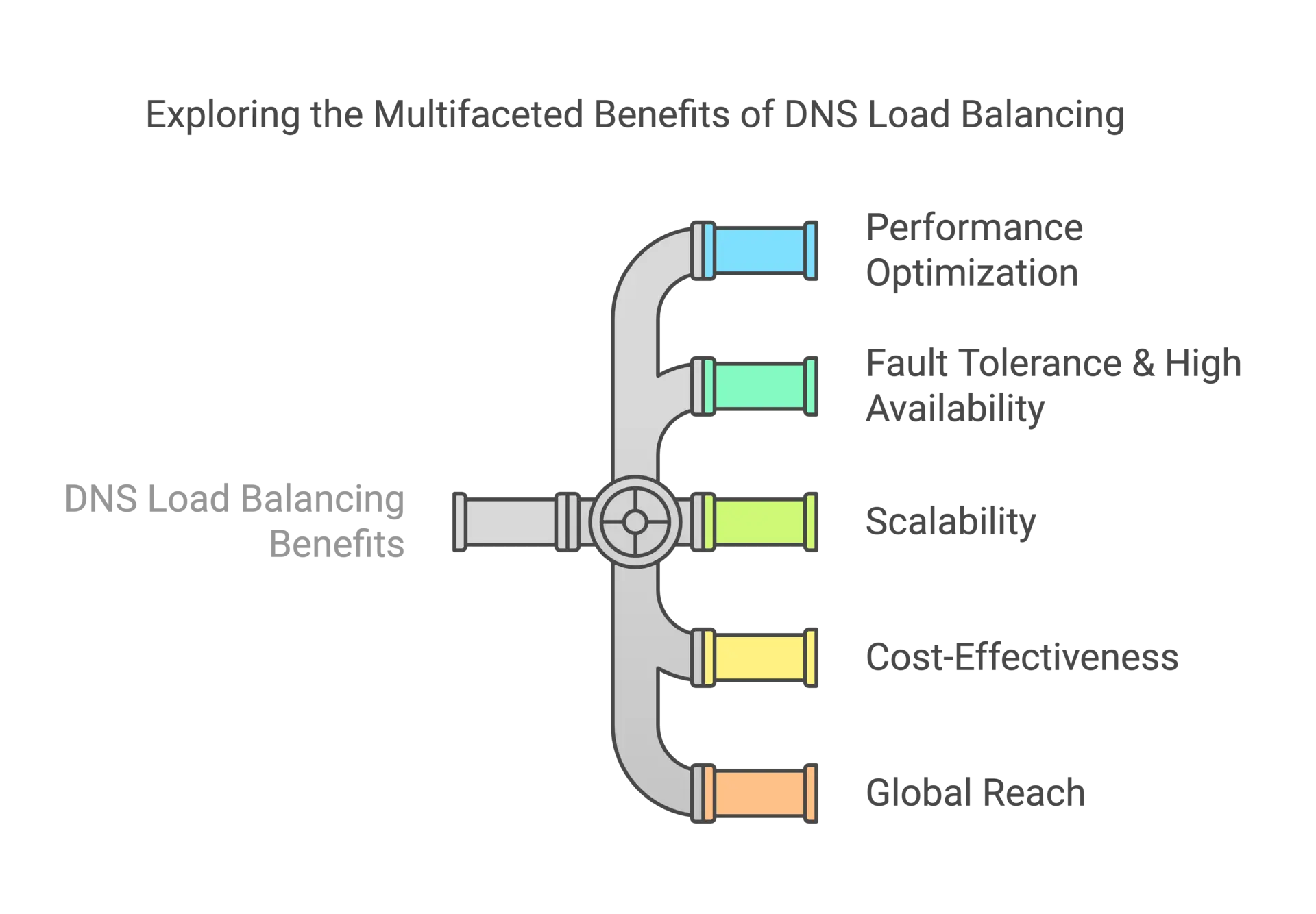
Challenges and Considerations
While DNS load balancing offers numerous benefits, it also comes with its own set of challenges and considerations. Understanding these limitations is crucial for implementing an effective and reliable load balancing strategy.
DNS Caching Issues
One of the primary challenges of DNS load balancing is the reliance on DNS caching. DNS responses are cached by clients and intermediate resolvers to reduce query latency and server load. However, this caching can lead to delays in traffic redistribution when changes are made to DNS records.
Key Issues:
- Delayed Updates: Changes to DNS records (e.g., adding or removing servers) may take time to propagate due to cached responses.
- Uneven Traffic Distribution: Users may continue to be directed to outdated or failed servers until the cache expires.
Mitigation Strategies:
- Lower TTL Values: Reduce the Time-to-Live (TTL) for DNS records to minimize caching duration. However, this increases DNS query volume and server load.
- Proactive Monitoring: Use tools to monitor DNS propagation and ensure updates are applied globally.
Lack of Real-Time Health Monitoring
Traditional DNS load balancing does not include built-in health checks, meaning it cannot detect server failures or performance issues in real time. This can result in traffic being directed to unhealthy servers, leading to poor user experiences.
Key Issues:
- Traffic to Failed Servers: Users may be directed to servers that are down or overloaded.
- Manual Intervention Required: Administrators must manually update DNS records to exclude unhealthy servers.
Mitigation Strategies:
- Integrate Health Checks: Use DNS providers that offer health monitoring (e.g., AWS Route 53, Cloudflare) to automatically exclude unhealthy servers.
- Hybrid Load Balancing: Combine DNS load balancing with application-layer load balancers (e.g., NGINX, HAProxy) for real-time health monitoring.
Propagation Delays
DNS updates can take time to propagate across the global DNS infrastructure. This delay can impact the effectiveness of DNS load balancing, especially during server failures or traffic spikes.
Key Issues:
- Slow Failover: Users may continue to be directed to failed servers until DNS updates propagate.
- Inconsistent User Experience: Some users may experience downtime or slow performance during the propagation period.
Mitigation Strategies:
- Use Anycast DNS: Anycast DNS routes queries to the nearest DNS server, reducing propagation delays.
- Plan for Failover: Implement automated failover mechanisms to quickly update DNS records during outages.
Limited Granularity
DNS load balancing operates at the DNS layer, which lacks the granularity of application-layer load balancers. It cannot make routing decisions based on application-level metrics like HTTP errors, server CPU usage, or session persistence.
Key Issues:
- No Application Awareness: DNS load balancing cannot optimize traffic based on application performance.
- Session Persistence: Users may be directed to different servers for subsequent requests, disrupting sessions.
Mitigation Strategies:
- Layer 7 Load Balancers: Use application-layer load balancers in conjunction with DNS load balancing for advanced traffic management.
- Sticky Sessions: Implement session persistence at the application layer to maintain user sessions.
Advanced DNS Load Balancing Solutions
To address the challenges of traditional DNS load balancing, modern solutions incorporate advanced features like health checks, dynamic traffic management, and integration with Content Delivery Networks (CDNs). Below, we explore these solutions in detail.
Health Checks and Monitoring
Health checks are a critical feature of advanced DNS load balancing solutions. They monitor the availability and performance of servers in real time and automatically exclude unhealthy servers from DNS responses.
How It Works:
- The DNS provider periodically sends health check requests to servers (e.g., HTTP/HTTPS requests).
- If a server fails to respond or returns an error, it is marked as unhealthy and removed from DNS responses.
- Once the server recovers, it is re-included in DNS responses.
Benefits:
- Improved Reliability: Ensures that traffic is only directed to healthy servers.
- Automated Failover: Reduces the need for manual intervention during server failures.
Example:
- AWS Route 53 health checks monitor HTTP endpoints and automatically update DNS records to exclude unhealthy servers.
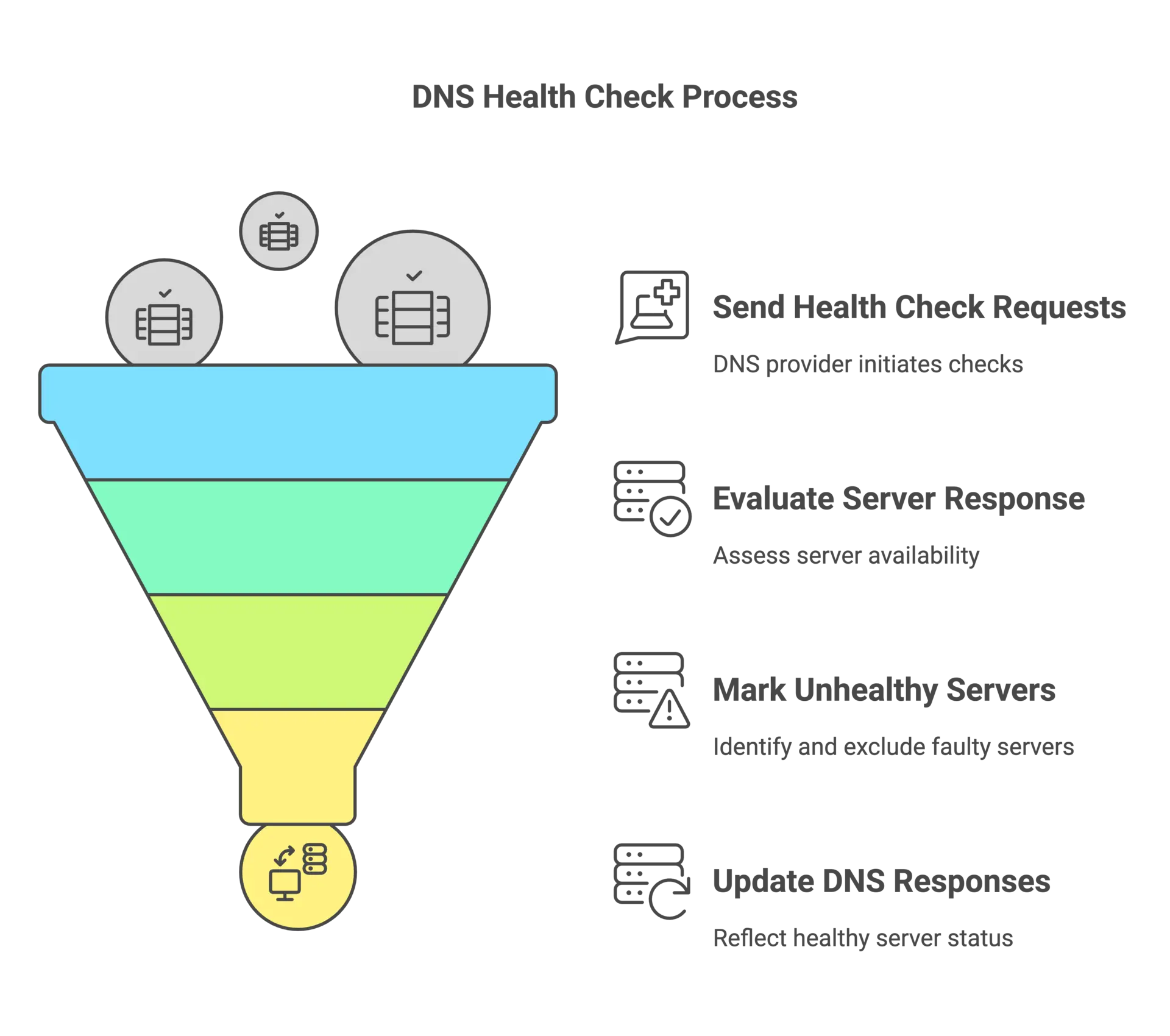
Dynamic Traffic Management
Dynamic traffic management adjusts routing policies in real time based on server load, network conditions, and user location. This ensures optimal performance and resource utilization.
How It Works:
- The DNS provider continuously monitors server load and network latency.
- Routing policies are dynamically adjusted to direct traffic to the best-performing servers.
- Users are routed to servers based on real-time conditions, such as lowest latency or least load.
Benefits:
- Optimal Performance: Ensures that users are always connected to the fastest or least congested server.
- Adaptability: Automatically adjusts to traffic spikes, network congestion, or server failures.
Example:
- Cloudflare’s load balancer uses real-time data to dynamically route traffic based on server health and latency.
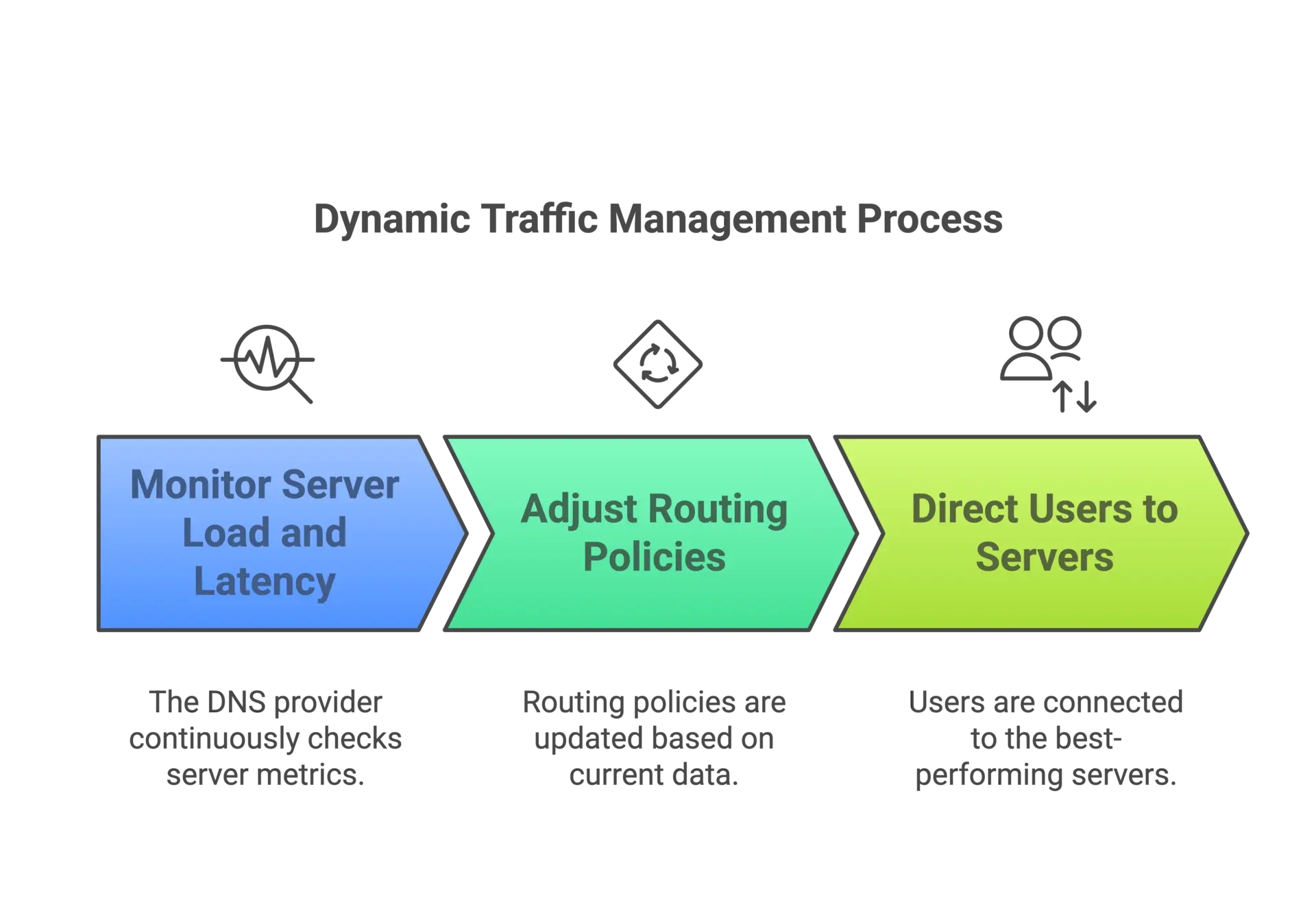
Integration with CDNs
Content Delivery Networks (CDNs) enhance DNS load balancing by caching content at edge servers located close to users. This reduces latency and improves performance for global applications.
How It Works:
- The CDN provider deploys edge servers in multiple geographic locations.
- DNS load balancing routes users to the nearest edge server.
- The edge server caches and delivers content, reducing the load on origin servers.
Benefits:
- Reduced Latency: Users receive content from nearby edge servers, improving response times.
- Scalability: Offloads traffic from origin servers, enabling them to handle more requests.
Example:
- Akamai’s CDN uses DNS load balancing to route users to the nearest edge server, ensuring fast and reliable content delivery.
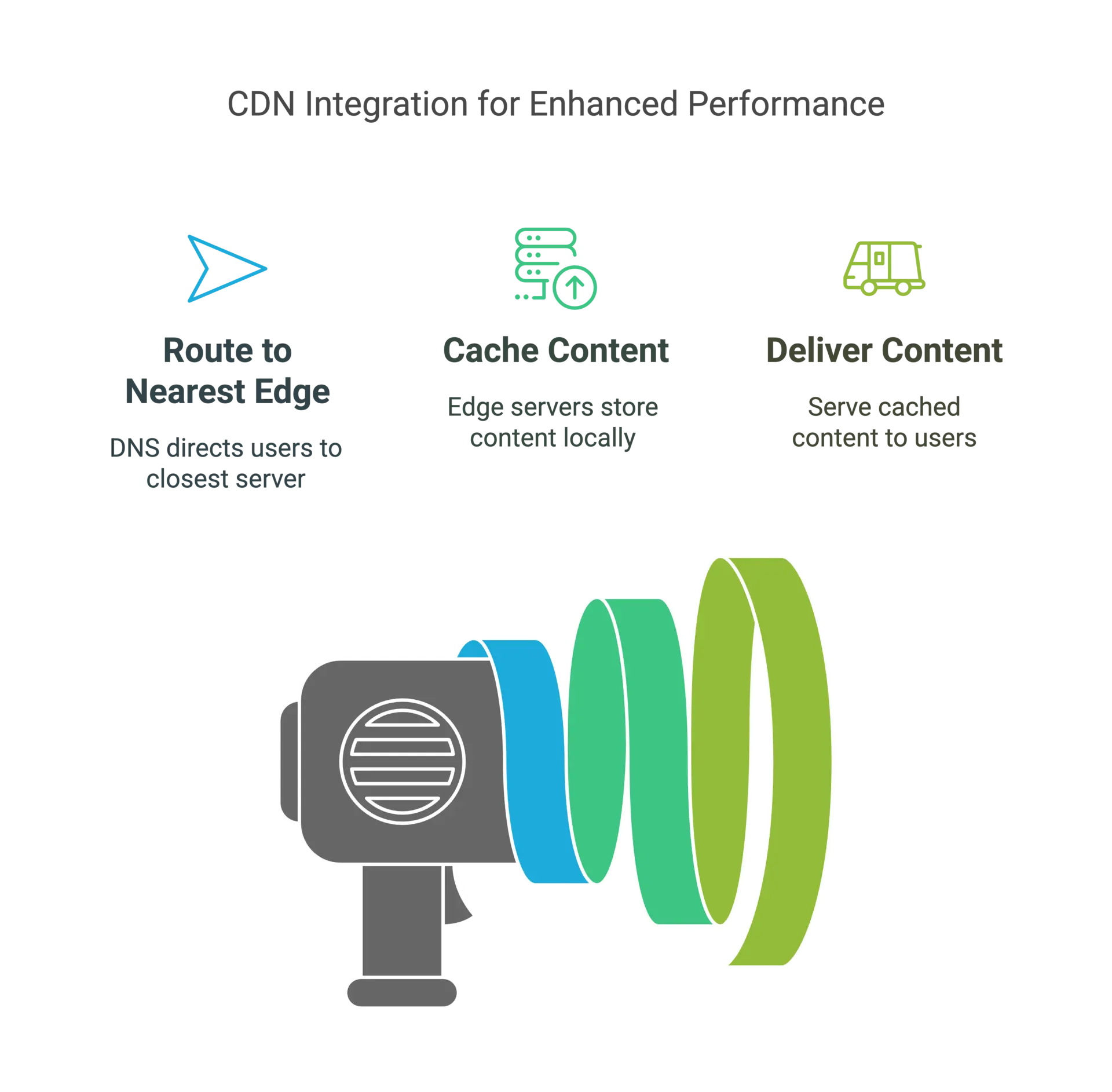
Tools and Services for DNS Load Balancing
Several tools and services provide advanced DNS load balancing features, making it easier for organizations to implement and manage load balancing strategies. Below, we explore some of the most popular options.
Amazon Route 53
Amazon Route 53 is a scalable and reliable DNS service that offers advanced load balancing features, including weighted, latency-based, and geolocation routing.
Key Features:
- Health Checks: Monitors server health and automatically excludes unhealthy servers.
- Traffic Policies: Supports weighted, latency-based, and geolocation routing.
- Integration with AWS: Seamlessly integrates with other AWS services like EC2, S3, and CloudFront.
Use Case:
- Ideal for businesses using AWS infrastructure and requiring scalable, global DNS load balancing.
Cloudflare DNS
Cloudflare DNS is a global anycast DNS service that provides performance and security features, including load balancing and DDoS protection.
Key Features:
- Anycast DNS: Routes queries to the nearest DNS server, reducing latency.
- Load Balancing: Supports weighted, latency-based, and geographic routing.
- Security: Includes built-in DDoS protection and DNSSEC.
Use Case:
- Suitable for organizations looking for a secure and high-performance DNS solution with global reach.
Google Cloud DNS
Google Cloud DNS is a scalable and low-latency DNS service that integrates with Google Cloud Platform (GCP) services.
Key Features:
- Global Anycast: Ensures low-latency DNS resolution worldwide.
- Health Checks: Monitors server health and updates DNS records dynamically.
- Integration with GCP: Works seamlessly with GCP services like Compute Engine and Kubernetes Engine.
Use Case:
- Ideal for businesses using Google Cloud Platform and requiring reliable DNS load balancing.
Conclusion
DNS load balancing is a powerful tool for optimizing performance, ensuring fault tolerance, and scaling web applications. By leveraging mechanisms like round-robin, weighted routing, and geographic routing, organizations can deliver faster and more reliable services to users worldwide. While DNS load balancing has its challenges, modern solutions like health checks and dynamic traffic management have significantly improved its effectiveness. As the internet continues to evolve, DNS load balancing will remain a cornerstone of global traffic management.